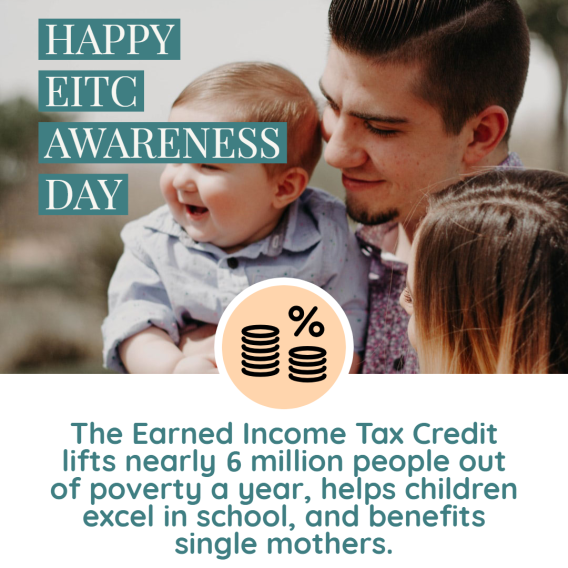Updated January 19, 2021
Congress approved a second and third round of stimulus checks for continued COVID relief. Learn more about the second stimulus check and the third stimulus check.Click on any of the following links to jump to a section:
Eligibility
1. What are Economic Impact Payments?
Economic Impact Payments –commonly referred to as “stimulus checks” or “recovery rebates”– are a key provision of the Coronavirus Aid Relief, and Economic Security (CARES) Act legislation that Congress passed to help reduce the financial burden on residents across the United States. The payments are an advance of a temporary credit for 2020 (which you file taxes for in 2021). Receiving the payment will not affect the amount of someone’s tax refund next year. They will still get a refund if they are eligible. Payments are non-taxable income that does not need to be paid back.
2. How much are Economic Impact Payments worth?
The payment is worth up to $1,200 for individuals or $2,400 for married couples. Up to $500 is provided for each qualifying child who is a dependent under 17 by the end of the tax year (December 31, 2018 or December 31, 2019 depending on the last tax returned filed). The amount of the payments starts to phaseout for single filers earning more than $75,000 ($150,000 for married couples, and $112,500 for heads of household).
3. How do Economic Impact Payments affect federal benefit programs like SNAP, Medicaid or TANF?
Economic Impact Payments will not impact one’s federal benefits. The payments are not counted as income during the month they are received and the following month and are they not counted as a resource for 12 months.
4. Who is eligible for Economic Impact Payments?
There are four main requirements, to qualify for the stimulus payments.
1. Income: There is no minimum income needed to qualify for the payment. Households with adjusted gross income (AGI) up to $75,000 for individuals or up to $150,000 if married filing jointly will receive the full payment. Payments for filers with income above these amounts is reduced by $5 for each $100 above the $75,000/$150,000 limits. Filers without children with income above $99,000, $136,500 if head of household, or $198,000 if married filing jointly are ineligible.
2. Taxpayer Identification Number (TIN): At least one tax filer must have a valid Social Security number (SSN). If a couple is married filing jointly, and one spouse has an SSN and one has an Individual Taxpayer Identification Number (ITIN), the spouse with an SSN and any children with SSNs or an Adoption Taxpayer Identification Number (ATIN) qualify for the additional $500 per child. (Children with ITINs do not qualify for payments.) If one spouse is an active member of the military, then both spouses are eligible for a stimulus check even if only one spouse has an SSN and the other spouse has an ITIN.
The COVID relief legislation passed in December 2020 modified this requirement. Previously, a valid SSN was required to receive a check. If a couple was married filing jointly, both spouses needed to have SSNs (one for military). If one spouse had an ITIN, then both spouses were ineligible for the stimulus check. For married military couples, the spouse with an SSN could still get the stimulus check for themselves but not the other spouse with an ITIN.
If someone was denied their first stimulus payment because they or their spouse did not have an SSN, they can claim their first stimulus check as the Recovery Rebate Tax Credit on their 2020 tax return.
3. Dependency: If someone is claimed as a dependent on a tax return, that person is ineligible to receive a payment for themselves. Children must be under 17 to qualify for the additional payment.
4. Citizenship or Residency: You must be a U.S. citizen, permanent resident, or qualifying resident alien.
5. Can someone who is incarcerated get an Economic Impact Payment?
Yes. Learn more about how people who are incarcerated can get stimulus checks here.
6. What if someone owes back taxes, child support, or student loan debt? What if someone is on a payment installment plan with the IRS?
Economic Impact Payments will not be intercepted if someone owes back taxes or student loan debt or is on an installment plan. If someone owes child support, their payment may be intercepted to collect child support arrears. The Bureau of the Fiscal Service will send a notice if this happens.
Financial institutions receiving directly deposited payments can deduct the payment for any outstanding overdraft fees. Private creditors may be able to garnish stimulus payments deposited in bank accounts for amounts owed on outstanding court judgments.
Helping people get their Economic Impact Payment
7. How does someone get Economic Impact Payments?
The IRS will calculate and send payments (by direct deposit or paper check) to eligible taxpayers who filed tax returns for either 2019 or 2018. Filing for an extension is not the same as filing a tax return. Social Security recipients, including Social Security Disability Insurance (SSDI), railroad retirees, and Supplemental Security Insurance (SSI) and Veterans Affairs (VA) beneficiaries (veterans, surviving spouses, or parents who receive Compensation and Pension (C&P) benefits) are not required to file a tax return. If someone already filed a 2019 tax return and received a refund, they do not need to do anything to get the payment. It will be delivered through the same method as their refund.
People who are not typically required to file a tax return will need to fill out an online form to receive the payment. They will need an email address to create an account and will be required to provide: their full name (and name of spouse, if present), current mailing address, date of birth, valid Social Security number, account and routing number for direct deposit, if available, Identity Protection Personal Identification Number (IP PIN) from the IRS, if received earlier this year, driver’s license or state-issued ID, if someone has one; and the following for each qualifying child: name, Social Security number or Adoption Taxpayer Identification Number, and their relationship to the filer or spouse.
It is important to note that some people under the tax filing threshold may be eligible for important tax credits like the Earned Income Tax Credit. They will want to file a tax return to claim these benefits instead of completing the online form.
8. Is there a deadline to get the Economic Impact Payment?
The IRS must receive people’s information by November 21, 2020 to issue payments this year. For many people, this means completing an online form. See question 7 on how to get payments for more information.
If someone is required to file a tax return AND owes taxes, they must file and pay the amount owed by July 15 to avoid late fees. If more time is needed to file taxes, a person can get an extension until October 15, 2020, but they will need to pay the tax owed by July 15 to avoid penalties.
If people receive Social Security, Social Security Disability Insurance (SSDI), or Supplemental Security Insurance (SSI); OR are a railroad retiree or Veterans Affairs (VA) beneficiary, they must send information to the IRS by November 21, 2020 to get their additional stimulus payment for qualifying children this year. They should use the IRS Non-filer tool to add the names and Social Security Numbers for their dependents. Learn more about qualifying dependents here.
If they miss these deadlines, they will be able to get their payment in 2021 by filing a 2020 tax return.
9. What if someone doesn’t have an email address?
An email address is needed for people to complete the online form if they don’t need to file taxes. The IRS will not email info about the payment. If someone doesn’t have an email address, you can help them create one for free through a webmail provider like Gmail or Yahoo! Mail.
If people are doing the online form themselves, they can also create a temporary email address using a site like 10minutemail.com or guerrillamail.com. These sites allow one to check messages sent to the address for a short period of time which will allow a person to confirm their account and form submission.
10. What if someone has moved or doesn’t have a permanent address?
The IRS is required to mail a notice of the payment to the last known address for each tax filer. The notice will be sent within 15 days after the payment is made and include: 1) payment amount, 2) payment method of delivery, and 3) an IRS contact number for questions about an undelivered payment.
A person can update their address when they submit a 2019 tax return. If someone has moved since last filing their 2019 tax return, they can update their address through the United States Postal Service. Alternatively, they can select a secure method to have the payment directly deposited.
If someone doesn’t have a permanent address, there are two general options to file a tax return and receive a refund:
- Use the address of a trusted family member or friend (with their consent).
- Find an organization or agency that allows people to use their address for tax purposes. Examples include shelters, health care clinics, and drop-in day centers. Additionally, service providers like Community Action Agency or Salvation Army are also options.
The IRS will deliver checks and notices to P.O. boxes.
11. What if someone doesn’t have a bank account to receive an Economic Impact Payment through direct deposit?
Direct deposit is the quickest and safest way to get payments. If someone doesn’t have a bank account, they can use a prepaid debit card, open a new bank account, use a payment app like CashApp, Venmo, or PayPal, or get a paper check in the mail.
If someone used a bank account on their most recent tax return that is no longer active, the IRS may attempt to deliver the payment using this information before the person can update their information through the portal. The person can notify the bank; however, the bank will most likely return the funds to the IRS. Depending on the timing, the IRS will likely distribute the payment as a paper check.
Prepaid Debit Cards
A prepaid debit card allows someone to receive their payment through direct deposit. People will want to get a card before filing taxes and may need to contact the company directly to obtain the account and routing numbers needed for direct deposit. Some free tax filing sites may offer prepaid debit cards along with select tax software companies that are part of IRS Free File. Additionally, commercial tax preparation companies such as H&R Block and TaxSlayer offer options to get a prepaid card during the tax filing process. These cards tend to have higher fees.
Bank Accounts
If someone doesn’t have an existing bank account, they can consider opening a new one. While there are a variety of barriers to becoming banked, this may be an option for some people. Like debit cards, there are several account options and it is important to evaluate accounts to assess the fees and requirements. The Cities for Financial Empowerment Fund works in partnership with local Bank On coalitions and financial institutions to connect consumers to safe, affordable bank accounts. View a list of accounts offered by financial institutions that meet national standards to identify options near you.
People should not provide the bank account information for someone else. Different names on the tax return and bank account will trigger a reject of the deposit, causing the IRS to send a check which will delay the delivery of the payment.
12. Can someone get their stimulus check on a debit card?
In May, the IRS issued 4 million debit cards with stimulus payments. The IRS selected recipients. People cannot request their stimulus on a debit card. The IRS has not indicated whether it will deliver future payments via debit card.
13. Where can someone get help filing a tax return to get their Economic Impact Payment?
The United Way has created a 211 Economic Impact Payment Helpline: 1-844-322-3639. It operates 24/7 with live agents available 8 am – 8 pm ET M-F through November 21, 2020. The Helpline can assist people with completing the online form and answer specific questions about the payment, including eligibility. Help is available in 180 languages.
Volunteer Income Tax Assistance (VITA) sites offer free, high quality tax preparation from IRS-certified volunteers. VITA sites help filers earning less than about $56,000 (some sites have different income guidelines). Due to the COVID-19 outbreak, many VITA sites are currently closed. Look up VITA sites in your area and call to learn if they are offering offer virtual services.
Online platforms that offer some assistance to people who want to file their own tax return for free include MyFreeTaxes.com and IRS Free File. Additionally, some tax software companies have developed a free version of their software for people who only need to file a tax return to receive the Economic Impact Payment.
14. When will Economic Impact Payments be delivered?
The IRS started distributing payments to people who already filed a 2019 or 2018 tax return and provided direct deposit information on April 9. Payments continued to be delivered via direct deposit throughout the month. Paper checks started to be mailed to people without direct deposit information at the end of April. Mailed payments are expected to have a significant delivery delay and some people will not receive payments for several months. See the chart at the end of this article for an estimated timetable for the IRS to mail checks.
If people complete the online form themselves, they should allow at least two weeks to get their payment through direct deposit or four weeks or more to receive their check in the mail.
The IRS’ Get My Payment tool allows one to look up the status of your payment, including the date when the payment is scheduled to be deposited or mailed.
15. Are there ways someone can get their Economic Impact Payment faster?
No, as long as they have direct deposit. Beware of scams! Some people are spreading information through phone calls, emails, text messages, and social media posts suggesting that people can get their payment quicker by sharing personal information and paying a “processing” fee. It is unnecessary to spend money to get this payment. The IRS will not contact anyone through these platforms. They will send written correspondence with instructions on steps to take and the timeframe for action. The IRS will never ask someone to share personal information – especially banking details – in a non-secure (email, text, or phone) method.
Additionally, the IRS refers to this money as an “Economic Impact Payment.” Communications that use “stimulus check” or “recovery rebate” are unlikely to be from the IRS. Encourage people to hang up on phone calls they receive and delete email or text messages that have any of these characteristics of a scam. One can report scams to the Better Business Bureau which helps protect others.
Troubleshooting
16. Can non-filers without access to the internet file a paper form to get their Economic Impact Payments?
Due to COVID-19, the IRS is not processing paper forms. Sending forms through the mail will delay the delivery of the payment. Advocates are encouraged to help connect people without internet access to assistance to file the form.
17. Do people who paid taxes electronically for their 2018 or 2019 tax return need to provide their bank account information?
Yes. While the IRS retains information used to deposit money into accounts, it is not authorized to use payment information provided to withdraw money from accounts. If someone owed taxes and paid them electronically (or by check), they will need to use the IRS Get My Payment tool to provide their bank account information if they don’t want to wait for a paper check.
18. How will people get their payment if they filed taxes with a Refund Anticipation Check (RAC) or Refund Anticipation Loan (RAL)?
The IRS will attempt to deliver the payment to the account information provided on the tax return. Some RALs and RACs are issued through debit cards. If the card is still active, the person will receive the payment on the card. If the account or card is no longer active, the deposit will be rejected, and the IRS will send a paper check to the address on the tax return. A person can check Get My Payment for updates on their payment delivery. If the payment has been directly deposited into an account that they don’t recognize or don’t have access to, they should contact the tax preparer who filed the return. If they are unable to reach them, contact your local Low Income Tax Clinic or Taxpayer Advocate Service (TAS) office for help.
19. What if someone has a child that wasn’t on the 2018 or 2019 return or they receive an Economic Impact Payment in the incorrect amount for another reason?
Social Security, Social Security Disability Insurance (SSDI), and Supplemental Security Insurance (SSI) recipients, railroad retirees, and Veterans Affairs (VA) beneficiaries can get the additional stimulus for their children this year by providing the IRS information about their dependents by November 21, 2020.
If someone filed a 2018 or 2019 tax return, their incorrect stimulus amount could be from a math error on the tax return. They can call the IRS EIP Hotline at 1-800-919-9835 or local Taxpayer Advocate Service (TAS) office to resolve the math error so the IRS can issue the missing payment.
If the IRS finds that someone has received a larger payment than they should have based on 2020 earnings, they will not be required to pay it back.
20. What if someone filed a joint 2019 tax return and is now separated or divorced, and the payment went to an account or address belonging to the former partner?
If the IRS delivers the payment to a bank account or address that belongs to a former partner, it will be a lengthy process for the person to get their payment. The IRS currently does not have a process to address this situation and views it as a civil matter. For assistance, contact your local Low Income Taxpayer Clinic, local Taxpayer Advocate Service, or community legal aid office.
One thing a person can do in the meantime is to document everything and request an EIP trace for their records. This will show that the payment went to the former spouse’s account. if the IRS develops procedures to address this issue, the person will have proof that they did not receive their EIP and could perhaps request a replacement payment from the IRS. Learn more on how to request an EIP trace here (under Q3).
21. How can someone check on the status of their Economic Impact Payment delivery?
The IRS’ Get My Payment tool allows people to check the status of their payment distribution. Users can look up the status of their payment, including the date when the payment is scheduled to be deposited or mailed.
22. What can someone do if they already filed a tax return and still haven’t gotten their payment?
If someone recently filed taxes, the IRS may still be processing the return. The IRS doesn’t have a person’s direct deposit info if they owed federal taxes, didn’t get a refund, or had their refund mailed. People should use the Get My Payment tool to add direct deposit details to get their payment sooner. If someone doesn’t have an account for direct deposit and cannot establish one, their payment will be mailed by check.
The IRS Get My Payment tool allows people to check on the status of their payment. It can take up to two weeks after filing a tax return or completing the online form for a status update to appear in Get My Payment.
If it’s been more than two weeks and you still get the “Status Not Available” message when you use Get My Payment, the IRS does not have all the information it needs to confirm your eligibility and calculate your payment. Recheck your confirmation email to make sure that your information was successfully accepted by the IRS. If it was, call the IRS EIP Hotline at 800-919-9835.
23. What if someone’s stimulus check was lost, stolen, or destroyed?
If a person provided direct deposit information to get their payment, they should first check with their bank, payment app, or debit card company to make sure they didn’t receive it.
You can help someone can request a trace of their stimulus check if they got Notice 1444 in the mail or if Get My Payment shows their payment was issued on a specific date, they haven’t gotten it, and it’s been more than:
- 5 days since the scheduled deposit date
- 4 weeks since it was mailed by check to a mailing address
- 6 weeks since it was mailed, and you have a forwarding address on file with the local post office
To start a trace of a stimulus check, call the IRS EIP Hotline at 1-800-919-9835 (expect long wait times due to limited staffing). Alternatively, you can complete and mail Form 3911, Taxpayer Statement Regarding Refund using the guidance found here (under Q3). Once the IRS receives the trace request, plan to wait at least six weeks for a response.
24. What if someone got their stimulus check on a debit card and lost it or threw it out?
They can request a replacement by calling 800-240-8100. Select option 2 from the main menu. The card will arrive in a plain envelope labeled “Money Network Cardholder Services” and will be issued by “Meta Bank, N.A.” The envelope will include instructions to activate the card, information on fees, and a note from the U.S. Treasury.
25. What if someone filed taxes last year under their previous name, and has changed their name since filing those taxes?
If someone files taxes and has not filed their 2019 taxes yet, they should file as soon as possible with their new name. They should make sure their name is updated with the Social Security Administration.
If a stimulus check is written out to someone under their previous legal name, they should still be able to deposit their check. However, they may need to speak with their bank and show legal paperwork documenting their court-ordered name change and old and new ID.
If someone is cashing a check outside of a bank, they should bring their legal documents with them and try to call in advance to make sure that they don’t have additional requirements to cash the check.
All information on this site is provided for educational purposes only and does not constitute legal or tax advice. The Center on Budget & Policy Priorities is not liable for how you use this information. Please seek a tax professional for personal tax advice.






